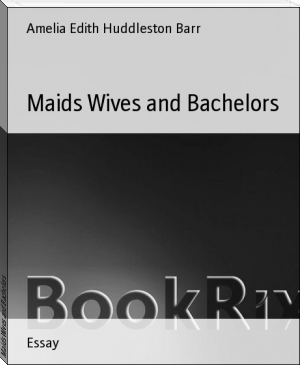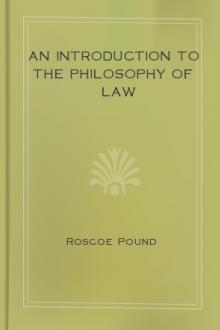Maids Wives and Bachelors, Amelia Edith Huddleston Barr [classic book list .txt] 📗

- Author: Amelia Edith Huddleston Barr
Book online «Maids Wives and Bachelors, Amelia Edith Huddleston Barr [classic book list .txt] 📗». Author Amelia Edith Huddleston Barr
The Ring Upon the Finger
Rings were probably the first ornaments ever worn, though in the earliest ages they had a meaning far beyond mere adornment. The stories of Judah and Tamar, of Pharaoh and Joseph, of Ahasuerus and Haman, show that as pledges of good faith, as marks of favor, and as tokens of authority, they were the recognized symbols. The fashion was an Eastern one, for the Jews were familiar with it before their sojourn in Egypt; indeed, it may have been one of those primeval customs which Shem, Ham, and Japhet saved from the wreck of an earlier world. Certainly the people of Syria and the lords of Palestine and Tyre used rings in the earliest times; and it is remarkable that they bore the same emblem which ancient Mexican rings bear,--the constellation of Pisces. As an ornament, however, the ring is least important; it is an emblem. The charmed circle has potency and romance.
Great faith in all ages has been placed in charmed rings. Greeks and Romans possessed them, and the Scandinavian nations had a superstitious faith in such amulets; indeed, as chronicles declare, it is hard to compute how much William was indebted for his victory over Harold to the influence of the ring he wore, which had been blessed and hallowed. As curative agencies, rings have also played a curious part. Until the Georgian era, rings blessed by the King or Queen on Good Friday were thought to control epilepsy and other complaints, and something of this secret power is still acknowledged by the superstitious, who wear around their necks rings or coins that have been blessed. Rings have also been agencies for death, as well as for life. In all ages they have been receptacles for subtle poisons, and thus Hannibal and Demosthenes armed themselves against an extremity of evil fortune.
In the life of the English Queen Elizabeth, rings had an extraordinary importance. She was notified of her ascension to the throne by the presentation of Mary's ring. The withholding of the ring sent by Essex caused her to die in a passion of remorse and re-awakened affection; and no sooner was the great struggle over than her ring was taken from her scarcely cold finger and flung out of the window to Sir John Harrington, who hastened over the Border with it to the Scottish James.
There are some curious traditions regarding the stones usually set in rings. The ruby or carbuncle was thought to guard against illness. The sapphire was the favorite of churchmen, and was thought to inspire pure desires. Epiphanes says the first tables of the Law were written on sapphires. The emerald bestowed cheerfulness and increased wealth. The opal was said to make a man invisible, the jacinth to procure sleep, and the turquoise to appease quarrels between man and wife. Things are much changed, however, since heathen sages and Rosicrucian alchemists defined the qualities and powers of gems. We have commercial "rings" now, which laugh emerald ones to scorn as means of procuring wealth. If the opal could make a man invisible, it might be popular on the first of a month, but we have better narcotics than the jacinth, while the elaborateness of our women's toilets gives husbands manifold opportunities of peace-making, quite as successful as the turquoise.
The Jews first used it in marriage. For this purpose they required it to have a certain value, and to be finally and fully purchased. If it was bought on credit, or taken as a gift, its power was destroyed. The Christian Church early adopted the custom of the marriage ring. It was placed first on the thumb, in the name of the "Father;" then removed to the first finger, in the name of the "Son;" to the third with the name of the "Holy Ghost;" and the "Amen" fixed its place on the fourth.
Rings were also the emblem of spiritual marriage and dignity as early as the third century. In the Romish Church the Episcopal ring is of gold set with a rich gem. The Pope has two rings, one bearing the likeness of St. Peter, used for ordinary business; the other bearing a cross, and the heads of both Peter and Paul, and the reigning Pope's name and arms. It is used only for Bulls, and is broken at the death of the Pontiff; and a new one given by the city of Rome to his successor. These rings of spiritual office were frequently worn on the thumb, and when the tomb of Bede was opened in May, 1831, a large thumb-ring was found where the right hand had fallen to dust.
The ring has been used not only for carnal and spiritual weddings, but also for commercial ones. For six hundred years the Doges of Venice married, with a gold ring, the Adriatic and its rich commerce to their city on the sea. As an emblem of delegated or transmitted power, the ring has also played a remarkable part in human affairs. Pharaoh and Ahasuerus in Biblical records are examples. Alexander transferred his kingdom to Perdicas with his ring. When Caesar received the head of Pompey, he also received his ring, and when Richard the Second resigned his crown to Henry of Lancaster, he did so by giving him his ring. The coronation ring of England is of gold, in which is set a large violet ruby, carved with the cross of St. George. The custom of engraving sacred emblems upon rings for common wear was angrily reproved by so early a sage as Pythagoras; and this heathen's delicacy about sacred things is commended to the notice of those women of our own day, who toss the holy symbol of our faith around the toilet tables, and wear it in very unconsecrated places.
However, I have said enough to prove that the ring upon our finger is a link between us and the centuries beyond the flood. We cannot escape this tremendous solidarity of the human race. We are part of all that has been, and the generations that follow us will look back to us and say, "They were our fathers, and we are their heirs, and lo, we are all one!"
Flirting Wives
If some good and thoughtful woman who died fifty years ago could return to this world, what in our present life would most astonish her? Would it be the wonders of steam, electricity, and science; the tyranny of the working classes, or the autocracy of servants? No! It would be the amazing development of her own sex,--the preaching, lecturing, political women; the women who are doctors and lawyers; who lose and win money on horses, or in stocks and real estate; the women who talk slang, and think it an accomplishment; who imitate men's attire and manners; who do their athletic exercises in public; and, perhaps more astonishing than all, the women who make marriage the cloak for much profitable post-nuptial flirtation.
For her own sex engaged in business, she might find excuses or even admiration; and even for the unfeminine girls of the era, she might plead Mrs. Poyser's opinion, that "the women are made to suit the men." But for young wives notorious for their flirting and their "followers," she could have nothing but unqualified scorn and condemnation. For the sentiment demanding absolute fidelity in a wife may be said to have the force of a human instinct; in all ages it has exacted from her an avoidance of the very appearance of evil. Therefore a good woman in the presence of a frivolous flirting wife feels as if a law of nature were being broken before her eyes; since behind the wife stands the possible mother, and the claims of family, race, and caste, as well as of conjugal honor, are all in her keeping.
Without any exaggeration it may be said that wife-errantry is now as common as knight-errantry once was. The young men of to-day have discovered the personal advantage and safety there is in the society of another man's wife. They transpose an old proverb, and practically say: "Fools marry, and wise men follow their wives." For, if the husband be only complacent, it is such a safe thing to flirt with a pretty wife. Young girls are dangerous and might lure them into matrimony; but they have no fear of bigamy. They can whisper sweet words to a gay, married flirt; they can walk, and talk, and dance, and ride with her; they can lounge in her dusky drawing-room or in her opera box, and no one will ask them the reason why, or make any suggestion about their "intentions."
How far this custom affects the morals of the woman is not at first obvious; but we must insist on this recognized premise: "Society has laid down positive rules regarding the modesty of women, and apart from these rules it is hard to believe modesty can exist. For all conventional social laws are founded on principles of good morals and good sense; and to violate them without a sufficient reason destroys nicety of feeling, sweetness of mind, and self-respect." It is no excuse to say that propriety is old-maidish, and that men like smart women, or that no harm is intended by their flirtations. The question is: Can married women preserve their delicacy of thought and their nobleness of manner; can they be truly loyal to their husbands and to themselves throughout the different phases of a recognized flirtation? It is an impossible thing.
Suppose a beautiful girl to be wooed and won by a man in every way suitable to her desires. She has accepted his love and his name, and vowed to cleave to him, and to him only, till death parts them. The wooing has been mainly done in full dress, at balls and operas, or in hours tingling with the expectancy of such conditions. The aroma of roses, the rustle of silks and laces, the notes of music, the taste of bon-bons and sparkling wines, were the atmosphere; and the days and weeks went by to the sense of flying feet in a ballroom, or to enchanted loiterings in greenhouses, and behind palms and flowers on decorated stairways.
The young wife is unwilling to believe that marriage has other and graver duties. She has been taught to live in the present only, and she is, therefore, cynical and apathetic concerning all things but dress and amusements. The husband has to return to business, which has been somewhat neglected; arrears of duty are to be met. He feels it necessary to attend to the question of supplies; he is, likely, a little embarrassed by the long holiday of wooing and honeymooning, and he would be grateful for some retrenchment and retirement, for the purpose of home-making.
The young wife has no such intentions; she resents and contradicts them on every occasion; and after the first pang of disappointment is over, he finds it the most prudent and comfortable plan to be indifferent to her continued frivolity. He is perhaps even flattered to find her so much admired; perhaps, in his heart, rather thankful to be relieved from the trouble of admiring her. As for any graver thoughts, he concludes that his wife is no worse than A's and B's and C's wives; that she is quite able to take care of herself, and that in a multitude of adorers there is safety.
Thus, in a majority of cases, begins the career of the married flirt. But the character is not a corollary of marriage, if the proper conditions were present when the wife was a young woman. There is no salvation in the Order of Matrimony; no miracles are wrought at the





Comments (0)